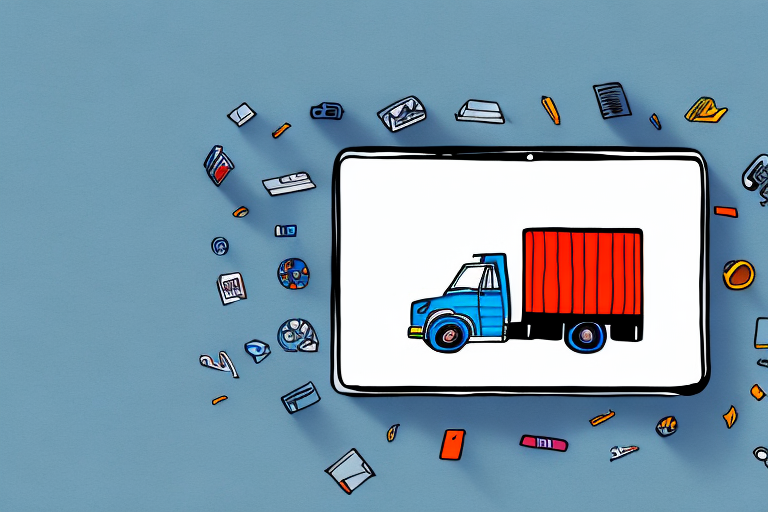The Benefits of Electronic Proof of Delivery
In today's fast-paced business environment, speed, efficiency, and transparency are critical factors that drive customer satisfaction. Traditional paper-based Proof of Delivery (POD) systems are increasingly becoming obsolete as businesses seek more effective solutions. Electronic Proof of Delivery (ePOD) systems offer a modern alternative that streamlines delivery processes, reduces errors and disputes, and enhances overall customer satisfaction. This article delves into the numerous advantages of ePOD, including real-time tracking, cost savings, and environmental sustainability. Additionally, we will provide guidance on selecting the right ePOD solution for your business and navigating the challenges associated with its implementation.
What is Electronic Proof of Delivery (ePOD) and How Does it Work?
Electronic Proof of Delivery (ePOD) is a digital system that replaces traditional paper-based POD methods, such as signed delivery receipts or bills of lading, with electronic records captured and stored on mobile devices like smartphones or tablets. The ePOD process involves equipping delivery drivers with these mobile devices, preloaded with specialized ePOD software. When a delivery or pickup is made, the driver uses the software to record essential delivery details, including the date, time, and recipient's name. The recipient then provides an electronic signature on the device's touchscreen, which is stored along with GPS coordinates or photographs, ensuring indisputable evidence of the delivery or pickup.
One significant advantage of ePOD is the elimination of paper-based documentation, which is prone to loss or damage. This shift not only saves time and money but also minimizes the risk of disputes or legal issues arising from incomplete or missing paperwork. Moreover, ePOD systems offer real-time tracking and visibility of deliveries, allowing customers to monitor their shipments and receive timely notifications about any delays or issues.
Additionally, ePOD enhances the accuracy and efficiency of delivery operations. By automating the capture of delivery details, ePOD systems reduce human errors and streamline processes such as invoicing and inventory management. This leads to improved customer service, reduced operational costs, and valuable data insights that can be leveraged to optimize delivery routes and schedules.
Streamlining Your Delivery Process with ePOD
Implementing an ePOD system can significantly streamline your delivery operations by eliminating the need for paper documentation, reducing manual data entry errors, and enhancing delivery accuracy. With ePOD, drivers have immediate access to delivery details and customer information, expediting the delivery process and minimizing the likelihood of missed or incorrect deliveries. The reduction in administrative paperwork also frees up valuable time, allowing your team to focus on more strategic tasks.
Furthermore, ePOD systems provide real-time tracking and monitoring of deliveries, offering businesses enhanced visibility into their delivery operations. This real-time data enables informed decision-making and swift resolution of any issues that may arise. Customers benefit from accurate delivery updates and estimated delivery times, which enhances their overall experience and satisfaction.
Real-time Tracking: The Key Advantage of ePOD
Real-time tracking is one of the most compelling benefits of ePOD systems. By capturing digital records of each delivery or pickup, ePOD provides instantaneous visibility into the status of deliveries, allowing businesses to monitor packages and the delivery process in real-time. This feature is particularly vital for industries where timely deliveries are critical, such as perishable goods, pharmaceuticals, and high-value items.
ePOD systems also incorporate enhanced security features, ensuring that only authorized personnel have access to delivery information. This reduces the risk of theft or fraud, providing businesses with peace of mind regarding the safety and integrity of their shipments.
Moreover, ePOD systems are instrumental in data collection and analysis. By aggregating data on delivery times, routes, and other key metrics, businesses can identify inefficiencies and areas for improvement. For instance, optimizing delivery routes based on traffic patterns and delivery volumes can lead to reduced fuel consumption and faster delivery times. According to a McKinsey report, optimizing delivery routes can cut delivery times by up to 15%, resulting in substantial cost savings.
Improved Customer Satisfaction with ePOD
ePOD systems play a pivotal role in enhancing customer satisfaction by providing real-time delivery updates and enabling customers to track the status of their orders. This transparency allows customers to receive accurate delivery estimates and stay informed about any potential delays, thereby fostering trust and reliability.
The ability for customers to sign for packages electronically adds a layer of convenience and security to the delivery process. This feature not only expedites the delivery but also reduces the risk of disputes related to lost or damaged packages. Enhanced service levels, facilitated by ePOD, contribute to increased customer loyalty and repeat business.
Moreover, ePOD reduces delivery errors by ensuring that the correct package is delivered to the right customer, at the correct location, and at the scheduled time. This precision minimizes customer frustration associated with incorrect or delayed deliveries, further elevating the customer experience.
Data insights derived from ePOD systems enable businesses to continually refine their delivery processes. For example, analyzing delivery data can highlight inefficiencies in route planning or inventory management, allowing businesses to implement targeted improvements that enhance delivery speed and accuracy. According to a study by Savi Technology, companies that leverage delivery data analytics see a 20% improvement in on-time deliveries.
Reduced Errors and Disputes with ePOD
ePOD systems significantly mitigate the risk of errors and disputes that are commonplace in traditional paper-based POD systems. By automating the capture of delivery records, ePOD eliminates the inaccuracies associated with manual data entry. Digital signatures and photographs serve as concrete evidence of deliveries or pickups, providing a verifiable record that can resolve or prevent disputes and chargebacks.
Furthermore, ePOD systems offer immediate notifications of any issues that arise during the delivery process, enabling businesses to proactively address problems before they escalate. This proactive approach not only prevents disputes but also enhances operational efficiency and customer trust.
From a financial perspective, ePOD systems reduce the costs associated with processing and storing paper records. Traditional POD systems require significant time and resources for manual processing, which can be especially burdensome for businesses handling large volumes of deliveries. ePOD streamlines this process by digitizing records, making them easily accessible and cost-effective to manage.
Additionally, ePOD enhances customer service by providing real-time updates on delivery status, including estimated delivery times and notifications of any delays. This transparency fosters trust and can lead to higher customer retention rates. According to a Business Insider study, 86% of buyers are willing to pay more for a better customer experience, highlighting the value of systems like ePOD that enhance service quality.
Cost Savings and Increased Efficiency with ePOD
The adoption of ePOD systems can lead to substantial cost savings and increased operational efficiency for businesses. By eliminating the need for paper-based documentation, ePOD reduces material costs and minimizes the time spent on manual data entry. This efficiency allows delivery drivers to complete more deliveries in less time, maximizing productivity.
ePOD systems also enhance route optimization and delivery scheduling, which can result in significant fuel savings and reduced vehicle maintenance costs. According to a report by the Bureau of Labor Statistics, optimized routing can lead to fuel savings of up to 10%, translating to considerable financial savings over time.
Moreover, the real-time tracking capabilities of ePOD provide businesses with greater control over their delivery operations. The ability to monitor and adjust routes dynamically ensures that deliveries are made efficiently, reducing the likelihood of delays and improving on-time delivery rates.
These efficiencies contribute to a higher return on investment (ROI) for businesses implementing ePOD systems. According to a GlobeNewswire report, the global ePOD market is expected to grow significantly, driven by the cost-saving and efficiency-enhancing benefits that businesses recognize.
Enhancing Transparency in the Delivery Process with ePOD
One of the most valuable benefits of ePOD systems is the enhanced transparency they provide throughout the delivery process. With ePOD, businesses gain comprehensive visibility into each step of the delivery journey, from dispatch to final delivery. This transparency allows for more accurate delivery estimates and real-time updates, which are crucial for maintaining customer trust and satisfaction.
Enhanced transparency also facilitates better communication between all stakeholders involved in the delivery process, including drivers, dispatchers, and customers. By having access to real-time data, businesses can quickly identify and resolve any issues that may arise, such as unexpected delays or misrouted packages.
Moreover, transparency in the delivery process helps businesses comply with industry regulations and standards. For example, in sectors like pharmaceuticals and food delivery, precise tracking and documentation are essential for ensuring product safety and regulatory compliance. ePOD systems provide the necessary tools to meet these stringent requirements effectively.
The Environmental Benefits of Going Digital with ePOD
Adopting ePOD systems contributes significantly to environmental sustainability by reducing the reliance on paper-based documentation. The elimination of paper not only decreases paper waste but also diminishes the environmental impact associated with paper production and disposal.
In addition to reducing paper waste, ePOD can lead to lower fuel consumption through optimized delivery routes and reduced travel times. This reduction in fuel usage results in decreased greenhouse gas emissions, contributing to better air quality and a smaller carbon footprint. According to the Environmental Protection Agency (EPA), optimizing delivery operations can significantly lower carbon emissions, aligning with corporate sustainability goals.
Furthermore, ePOD supports the broader trend of digital transformation, which promotes more sustainable business practices across various industries. By adopting digital tools like ePOD, businesses can demonstrate their commitment to environmental stewardship, which can enhance their reputation and appeal to environmentally conscious consumers.
Integrating ePOD into Your Existing Systems: A Step-by-Step Guide
Implementing an ePOD system involves integrating the technology seamlessly into your existing infrastructure and processes. While the process can be complex, a structured approach can facilitate a smooth transition. Below is a step-by-step guide to integrating ePOD into your business operations:
- Assess Your Needs: Begin by evaluating your current delivery processes and identifying areas where ePOD can add value. Consider factors such as the size of your delivery fleet, the volume of deliveries, and specific industry requirements.
- Select the Right ePOD Solution: Research and choose an ePOD system that aligns with your business needs. Key features to consider include user-friendliness, integration capabilities, real-time tracking, data analytics, and customer support.
- Train Your Staff: Proper training is essential for ensuring that your drivers and administrative staff can effectively use the ePOD system. Training should cover the operation of mobile devices, the use of ePOD software, and troubleshooting common issues.
- Integrate with Existing Systems: Ensure that the ePOD system integrates smoothly with your existing IT infrastructure, such as your logistics, inventory management, and customer relationship management (CRM) systems. This integration facilitates data sharing and streamlines operations.
- Pilot the Implementation: Conduct a pilot program to test the ePOD system in a controlled environment. This allows you to identify and address any issues before a full-scale rollout.
- Full Deployment: Once the pilot is successful, proceed with the full deployment of the ePOD system across your entire delivery network. Monitor the implementation closely and gather feedback to make any necessary adjustments.
- Continuous Improvement: Regularly review the performance of the ePOD system and seek opportunities for optimization. Leverage data analytics to enhance delivery efficiency and customer satisfaction continuously.
Choosing the Right ePOD Solution for Your Business
Selecting the appropriate ePOD solution is crucial for maximizing the benefits of digitalizing your delivery processes. Here are key considerations to guide your decision:
- Scalability: Choose an ePOD system that can scale with your business growth. It should accommodate an increasing number of deliveries and integrate new features as needed.
- Integration Capabilities: Ensure that the ePOD solution can seamlessly integrate with your existing software systems, such as logistics management, inventory control, and CRM platforms.
- User-Friendliness: The system should be intuitive and easy to use for your drivers and administrative staff. A user-friendly interface reduces the learning curve and minimizes resistance to adoption.
- Real-time Tracking and Reporting: Opt for an ePOD system that offers robust real-time tracking capabilities and comprehensive reporting tools. These features are essential for monitoring delivery performance and making informed decisions.
- Customer Support: Reliable customer support is vital for addressing any technical issues or questions that may arise during implementation and ongoing use.
- Security Features: The ePOD system should have strong security measures in place to protect sensitive delivery data and prevent unauthorized access.
Evaluating these factors will help you select an ePOD solution that aligns with your operational needs and strategic goals.
Overcoming Common Challenges in Implementing ePOD
While the benefits of ePOD systems are substantial, businesses may encounter several challenges during implementation. Addressing these challenges proactively can facilitate a successful transition to digital proof of delivery:
- Driver Adoption: Resistance from drivers can hinder the successful adoption of ePOD systems. To overcome this, provide comprehensive training and demonstrate how ePOD can make their jobs easier and more efficient.
- System Integration: Integrating ePOD with existing IT infrastructure can be technically complex. Collaborate with your ePOD provider to ensure compatibility and seamless data flow between systems.
- Customer Acceptance: Some customers may be hesitant to accept digital signatures or real-time tracking. Educate your customers on the benefits of ePOD, such as increased transparency and improved service reliability.
- Technical Issues: Technical glitches or downtime can disrupt delivery operations. Ensure that your ePOD provider offers reliable support and robust system performance to minimize disruptions.
- Data Privacy Concerns: Protecting customer data is paramount. Implement strong data security measures and comply with relevant data protection regulations to safeguard sensitive information.
By anticipating these challenges and implementing effective strategies to address them, businesses can ensure a smooth and successful ePOD implementation.
Case Studies: How Other Businesses Have Benefited from Implementing ePOD
Real-world examples illustrate the transformative impact of ePOD systems across various industries. Here are some case studies highlighting the benefits experienced by businesses that have adopted ePOD:
Logistics
A leading logistics company implemented an ePOD system to enhance its delivery operations. The system provided real-time tracking and automated data capture, resulting in a 25% reduction in delivery times and a 30% decrease in delivery errors. Additionally, customer satisfaction scores improved by 20% due to more accurate delivery estimates and enhanced communication.
Healthcare
A pharmaceutical distribution company adopted ePOD to ensure the accurate and timely delivery of medications. The ePOD system enabled precise tracking of deliveries, reducing the incidence of lost or misdelivered packages by 40%. Compliance with regulatory requirements was also improved through detailed digital records, ensuring the integrity of sensitive medical shipments.
Retail
A major retail chain integrated ePOD to manage its extensive delivery network. The ePOD system facilitated efficient inventory management and real-time order tracking, leading to a 15% increase in delivery capacity and a 10% boost in online sales. Customer feedback highlighted the convenience of tracking orders and the reliability of delivery commitments.
These case studies underscore the versatility and effectiveness of ePOD systems in enhancing operational efficiency, reducing errors, and improving customer satisfaction across diverse sectors.
Future Trends in Electronic Proof of Delivery Technology
The landscape of ePOD technology is continually evolving, with advancements poised to further enhance its capabilities and benefits. Emerging trends include:
Artificial Intelligence (AI)
AI integration into ePOD systems can enable predictive analytics, optimizing delivery routes based on real-time traffic data and historical delivery patterns. AI-driven insights can enhance decision-making, improve efficiency, and anticipate potential delivery challenges before they arise.
Blockchain Technology
Blockchain can introduce an extra layer of security and transparency to ePOD systems. By creating immutable records of deliveries, blockchain ensures data integrity and can facilitate trust among stakeholders through decentralized verification.
Internet of Things (IoT)
IoT devices, such as smart sensors and connected vehicles, can provide continuous data streams to ePOD systems. This integration can offer more granular tracking information, monitor environmental conditions during deliveries, and automate responses to various logistical scenarios.
Mobile Automation
Advancements in mobile technology will continue to make ePOD systems more user-friendly and feature-rich. Enhanced mobile interfaces and functionalities will streamline the data capture process, making it easier for drivers to use ePOD systems on the go.
These trends indicate a future where ePOD systems become even more integral to efficient and secure delivery operations, driving further innovations in logistics and supply chain management.
Conclusion: Why You Should Consider Adopting ePOD for Your Business
Electronic Proof of Delivery (ePOD) has transitioned from being a luxury to a necessity in today’s dynamic, customer-centric market. The comprehensive benefits of ePOD—from real-time tracking and enhanced transparency to reduced errors and disputes—highlight its pivotal role in optimizing delivery operations. By adopting ePOD, businesses can achieve significant cost savings, improve operational efficiency, and enhance customer satisfaction.
Furthermore, ePOD contributes to environmental sustainability by reducing paper waste and optimizing delivery routes, aligning business practices with global sustainability goals. The ability to collect and analyze delivery data also empowers businesses to make informed decisions, driving continuous improvement and innovation.
As technology continues to advance, integrating ePOD systems with AI, blockchain, and IoT will unlock even greater potential, keeping businesses ahead of the competition and responsive to evolving market demands. Implementing ePOD not only elevates the efficiency and reliability of your delivery processes but also strengthens your reputation as a forward-thinking, customer-focused organization.
Don’t wait to harness the benefits of electronic proof of delivery. Start exploring your ePOD options today and experience the transformative impact it can have on your business operations and customer relationships.




















